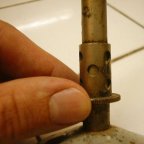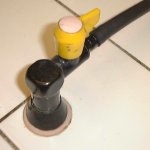Triple Beam Balance
by Liz LaRosa
Objectives:
-
to learn the correct way to use a Triple Beam Balance
-
to learn the parts of a Triple Beam Balance.
-
to take precise measurements when finding the mass of an object
-
to find the mass of known and unknown quantities
Materials:
-
Film canisters labeled A - Z filled with different masses.
-
Sets of Brass weights 200, 100, 50, 20, 10, 5, 2, & 1 gram
-
Triple Beam Balances
Procedure:
-
Listen and watch carefully to the demonstration on how to use the Triple Beam Balance.
-
You and your partner will share a triple beam balance.
-
Check to see that the Pointer is pointing to zero.
-
If it is not, check to see that all the Riders are all the way to the left at the Zero mark.
-
Adjust the balance by turning the Adjustment Screw slowly until it points to zero.
-
Place the known brass weights onto the pan and practice measuring until you are comfortable using the balance beam. Start with the largest mass, 200 g, and work your way down to the smallest mass, 1 g.
-
Find the mass of the unknown film canisters.
-
Record canister letter and mass in Table 1.
Data:
Table 1: Mass of unknown film canisters in grams.
| Canister _____ | Canister _____ | Canister _____ | Canister _____ | Canister _____ | |
| Grams |
Analysis and Results:
-
How should you hold a triple beam balance?
-
Why should your balance say zero before you place an object in the pan?
-
What canister had the largest mass? Letter _________ with _______ grams
-
Was it easier to find the mass of an object with a lot of mass or a little amount of mass? Explain.
-
Should our balance beam be renamed to a "Quadruple Beam Balance" - Explain.
Conclusion:
2 - 3 complete sentences on what you learned.
Parts

Introduction:
The Bunsen burner is used in laboratories to heat things. In order to use it safely and appropriately, it is important to know the correct steps on how to set it up and operate it. A Bunsen burner can produce 3 different types of flames:
| The "coolest" flame is a yellow / orange color. It is approximately 300°C. It is never used to heat anything, only to show that the Bunsen burner is on. It is called the safety flame. | The medium flame, also called the blue flame or the invisible flame is difficult to see in a well-lit room. It is the most commonly used flame. It is approximately 500°C. | The hottest flame is called the roaring blue flame. It is characterized by a light blue triangle in the middle and it is the only flame of the 3 which makes a noise. It is approximately 700°C. |
|
|  |  |
Lighting the Bunsen burner:
Step 1
The first step is to check for safety - lab coat on, long hair tied back, safety glasses on, books and papers away from the flame, apparatus set up not too close to the edge of the table...
Step 2
The second step is to look at the holes. Check that the holes are closed. The holes can be adjusted to let in more or less air by turning the collar (see photos below).
Open:
Closed:
Step 3
Wait for the teacher's permission, then light the match. Some people prefer to turn the gas on and light the match after. The problem is, if the match breaks or goes out, the gas is leaking out of the tap while you get a new match.
Step 4
Light the Bunsen burner. When you have a flame from the match, turn on the gas tap. To turn it on, you must first push down, then turn the tap. This is a safety feature so the taps are not accidentally pushed open. Approach the match to the top of the Bunsen burner and it should light.
Tap closed:
Tap open:
Step 5
Adjust the flame by turning the collar so that you have the appropriate flame for the experiment (usually the medium blue flame).
Step 6
During the experiment, stay vigilant so that if a problem occurs, you are ready to turn off the flame quickly. This means that you should not leave your table unattended.
Formulas
Select an equation to solve for a different unknown
| Solve for density | |
| Solve for mass | |
| Solve for volume |
Where
| d | = | density |
| m | = | mass |
| v | = | volume
|
Evaporation
Evaporation is the vaporization of a liquid and the reverse of condensation. A type of phase transition, it is the process by which molecules in a liquid state (e.g. water) spontaneously become gaseous (e.g. water vapor). Generally, evaporation can be seen by the gradual disappearance of a liquid from a substance when exposed to a significant volume of gas.Factors influencing the rate of evaporation
- Pressure
- In an area of less pressure, evaporation happens faster because there is less exertion on the surface keeping the molecules from launching themselves.
- Surface area
- A substance which has a larger surface area will evaporate faster as there are more surface molecules which are able to escape.
- Temperature of the substance
- If the substance is hotter, then evaporation will be faster.
- Density
- The higher the density, the slower a liquid evaporates.
In the US, the National Weather Service measures the actual rate of evaporation from a standardized "pan" open water surface outdoors, at various locations nationwide. Others do likewise around the world. The US data is collected and compiled into an annual evaporation map. The measurements range from under 30 to over 120 inches (3,000 mm) per year.
Decantation
Decantation is a process for the separation of mixtures, carefully pouring a solution from a container in order to leave the precipitate (sediments) in the bottom of the original container. Usually a small amount of solution must be left in the container, and care must be taken to prevent a small amount of precipitate from flowing with the solution out of the container. It is generally used to separate a liquid from an insoluble solid.Filtration
Filtration is a mechanical or physical operation which is used for the separation of solids from fluids (liquids or gases) by interposing a medium through which only the fluid can pass.Distillation

Distillation is a method of separating mixtures based on differences in their volatilities in a boiling
Distillation is a method of separating mixtures based on differences in their volatilities in a boiling liquid mixture. Distillation is a unit operation, or a physical separation process, and not a chemical reaction.







thats great , u remind me , my chemistry subject , good job ,
ReplyDelete